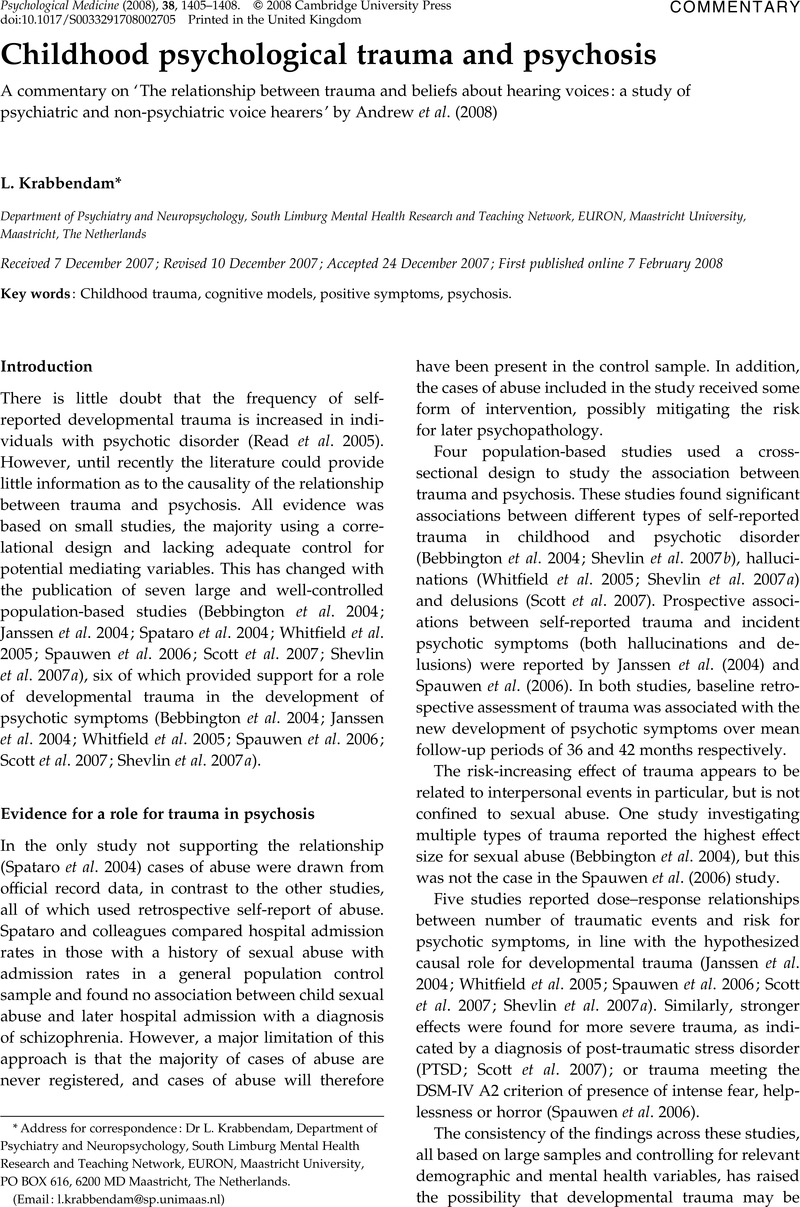Crossref Citations
This article has been cited by the following publications. This list is generated based on data provided by Crossref.
Thompson, Judy L.
Kelly, Meredith
Kimhy, David
Harkavy-Friedman, Jill M.
Khan, Shamir
Messinger, Julie W.
Schobel, Scott
Goetz, Ray
Malaspina, Dolores
and
Corcoran, Cheryl
2009.
Childhood trauma and prodromal symptoms among individuals at clinical high risk for psychosis.
Schizophrenia Research,
Vol. 108,
Issue. 1-3,
p.
176.
Lovatt, Anna
Mason, Oliver
Brett, Caroline
and
Peters, Emmanuelle
2010.
Psychotic-Like Experiences, Appraisals, and Trauma.
Journal of Nervous & Mental Disease,
Vol. 198,
Issue. 11,
p.
813.
Goldstone, Eliot
Farhall, John
and
Ong, Ben
2011.
Synergistic pathways to delusions: enduring vulnerabilities, proximal life stressors and maladaptive psychological coping.
Early Intervention in Psychiatry,
Vol. 5,
Issue. 2,
p.
122.
Burns, Jonathan Kenneth
Jhazbhay, Khatija
Esterhuizen, Tonya
and
Emsley, Robin
2011.
Exposure to trauma and the clinical presentation of first-episode psychosis in South Africa.
Journal of Psychiatric Research,
Vol. 45,
Issue. 2,
p.
179.
Alemany, S.
Goldberg, X.
van Winkel, R.
Gastó, C.
Peralta, V.
and
Fañanás, L.
2013.
Childhood adversity and psychosis: Examining whether the association is due to genetic confounding using a monozygotic twin differences approach.
European Psychiatry,
Vol. 28,
Issue. 4,
p.
207.
Bonoldi, Ilaria
Simeone, Ercole
Rocchetti, Matteo
Codjoe, Louisa
Rossi, Giorgio
Gambi, Francesco
Balottin, Umberto
Caverzasi, Edgardo
Politi, Pierluigi
and
Fusar-Poli, Paolo
2013.
Prevalence of self-reported childhood abuse in psychosis: A meta-analysis of retrospective studies.
Psychiatry Research,
Vol. 210,
Issue. 1,
p.
8.
Tikka, Maria
Luutonen, Sinikka
Ilonen, Tuula
Tuominen, Lauri
Kotimäki, Mika
Hankala, Juha
and
Salokangas, Raimo K.R.
2013.
Childhood trauma and premorbid adjustment among individuals at clinical high risk for psychosis and normal control subjects.
Early Intervention in Psychiatry,
Vol. 7,
Issue. 1,
p.
51.
Campbell, Clodagh
Barrett, Suzanne
Shannon, Ciaran
Hoy, Katrina
Rushe, Teresa
Cooper, Stephen
and
Mulholland, Ciaran
2013.
The relationship between childhood trauma and neuropsychological functioning in first episode psychosis.
Psychosis,
Vol. 5,
Issue. 1,
p.
48.
Velthorst, Eva
Nelson, Barnaby
O’Connor, Karen
Mossaheb, Nilufar
de Haan, Lieuwe
Bruxner, Annie
Simmons, Magenta B.
Yung, Alison R.
and
Thompson, Andrew
2013.
History of trauma and the association with baseline symptoms in an Ultra-High Risk for psychosis cohort.
Psychiatry Research,
Vol. 210,
Issue. 1,
p.
75.
Kraan, Tamar
Velthorst, Eva
Smit, Filip
de Haan, Lieuwe
and
van der Gaag, Mark
2015.
Trauma and recent life events in individuals at ultra high risk for psychosis: Review and meta-analysis.
Schizophrenia Research,
Vol. 161,
Issue. 2-3,
p.
143.
Shevlin, Mark
McElroy, Eoin
Christoffersen, Mogens Nygaard
Elklit, Ask
Hyland, Philip
and
Murphy, Jamie
2016.
Social, familial and psychological risk factors for psychosis: A birth cohort study using the Danish Registry System.
Psychosis,
Vol. 8,
Issue. 2,
p.
95.
Selk, Sabrina C
Rich-Edwards, Janet W
Koenen, Karestan
and
Kubzansky, Laura D
2016.
An observational study of type, timing, and severity of childhood maltreatment and preterm birth.
Journal of Epidemiology and Community Health,
Vol. 70,
Issue. 6,
p.
589.
Kilian, S.
Burns, J. K.
Seedat, S.
Asmal, L.
Chiliza, B.
Du Plessis, S.
Olivier, M. R.
Kidd, M.
Emsley, R.
and
Maher, Brion
2017.
Factors Moderating the Relationship Between Childhood Trauma and Premorbid Adjustment in First-Episode Schizophrenia.
PLOS ONE,
Vol. 12,
Issue. 1,
p.
e0170178.
Bolhuis, K.
Koopman‐Verhoeff, M. E.
Blanken, L. M. E.
Cibrev, D.
Jaddoe, V. W. V.
Verhulst, F. C.
Hillegers, M. H. J.
Kushner, S. A.
and
Tiemeier, H.
2018.
Psychotic‐like experiences in pre‐adolescence: what precedes the antecedent symptoms of severe mental illness?.
Acta Psychiatrica Scandinavica,
Vol. 138,
Issue. 1,
p.
15.
Huang, Zhuo-Hui
Hou, Cai-Lan
Huang, Ying-Hua
He, Xiao-Yan
Wang, Qian-Wen
Chen, Xie
Wang, Zhong-Lei
Wang, Shi-Bin
and
Jia, Fu-Jun
2019.
Individuals at high risk for psychosis experience more childhood trauma, life events and social support deficit in comparison to healthy controls.
Psychiatry Research,
Vol. 273,
Issue. ,
p.
296.
Brink, Vera
van Driel, Catheleine
el Bouhaddani, Saliha
Wardenaar, Klaas J.
van Domburgh, Lieke
Schaefer, Barbara
van Beilen, Marije
Bartels-Velthuis, Agna A.
and
Veling, Wim
2020.
Spontaneous discontinuation of distressing auditory verbal hallucinations in a school-based sample of adolescents: a longitudinal study.
European Child & Adolescent Psychiatry,
Vol. 29,
Issue. 6,
p.
777.
Edwards, Emily R.
Rose, Nina L. J.
Gromatsky, Molly
Feinberg, Abigail
Kimhy, David
Doucette, John T.
Goodman, Marianne
McClure, Margaret M.
Perez-Rodriguez, M. Mercedes
New, Antonia S.
and
Hazlett, Erin A.
2021.
Alexithymia, Affective Lability, Impulsivity, and Childhood Adversity in Borderline Personality Disorder.
Journal of Personality Disorders,
Vol. 35,
Issue. Supplement A,
p.
114.
Gkintoni, Evgenia
Skokou, Maria
and
Gourzis, Philippos
2024.
Integrating Clinical Neuropsychology and Psychotic Spectrum Disorders: A Systematic Analysis of Cognitive Dynamics, Interventions, and Underlying Mechanisms.
Medicina,
Vol. 60,
Issue. 4,
p.
645.



